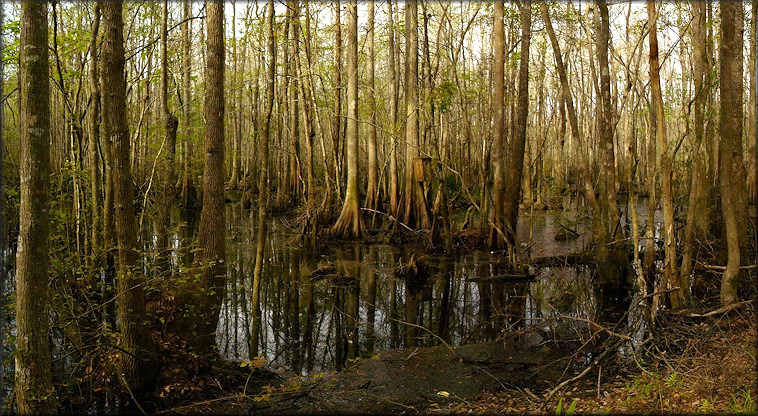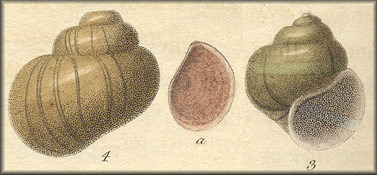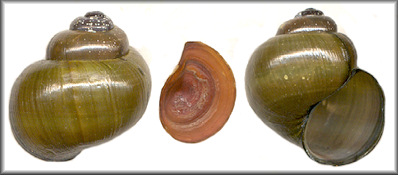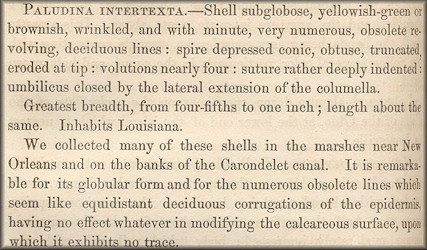|
Abstract: Two mollusk collections, roughly spanning the 30-year existence of
the Crosby Sanctuary, are reported.
Selected zoogeographic,
archaeological, historic, nomenclatorial, and taxonomic aspects of this
fauna, numbering 30 species, are discussed relevant to three large aquatic
gastropods, Viviparus georgianus, V. intertextus, and Pomacea
paludosa.
The
Duval Audubon Society (DAS) administers a tract of 408 acres of
predominantly bottomland hardwood swamp donated by J. Ellis and Addie Weltch
Crosby in the early 1980's (Crosby
Sanctuary). This land is a segment of a
major wildlife habitat corridor between the Ortega River (McGirts Creek), on
which I live, and Black Creek, in Duval and Clay Counties respectively.
On June 22, 1980, during the lengthy process of land-transfer, I accompanied Lenore McCullagh, who served as DAS liaison with the Crosbys, and her husband, Henry,
my partner in medical practice, on a riverine reconnaissance of the property
with a focus on its malacofauna. After parking on the west side of Blanding
Blvd. near the Duval-Clay boundary, we launched our canoe from the
right bank of McGirts and paddled upstream about an half-mile. Almost
immediately we reached the NE corner of the tract and traced its northern
boundary on our left while we proceeded roughly westward. Progress was leisurely
as we sampled the sandy bottom and submerged vegetation in the tannin-stained
but clear waters. Girding the serpiginous watercourse through much of this
stretch is paralotic swampland. Here we occasionally put ashore in the cool
shade and prospected for land snails on habitable patches within the hydric
hammock, in which Bald-cypress, Red Maple, Sweetgum, and Tupelo were the
dominant cover.
It was a pleasant excursion. Furthermore, the
periodically-edited species account in my field log indicates 22 species, all
but four aquatic, were collected at this (extended) station. That's a healthy chunk of
biodiversity - maybe not by ornithological standards, but reasonably robust by NE
Florida molluscan measure; see Highlights among Northeast
Florida non-marine mollusk survey locations.
These
taxa are among those tabulated in the appendix below.
In May of this year, Jacksonville Shell Club (JSC) member and scientific author,
Heather McCarthy (McCarthy and Lisenby, 2010), asked me about the status of a NE
Florida aquatic snail, Amnicola rhombostoma (F. Thompson, 1968) the
Squaremouth Amnicola, described from Peters Creek in Clay Co. and historically
known from less than a dozen places in Clay, Putnam and St. Johns Cos. Heather
could find no evidence the species had been collected since 1981. Since I had
reason to believe it might be living in McGirts Creek, Heather called a meeting
at the newly-opened Marine Science Research Institute of Jacksonville University (site of the October
27 JSC meeting). On September 13 I met Heather and two St. Johns Riverkeeper
professionals, Jimmie Orth and Kelly Savage, in Jimmie's office. We ultimately
decided to join forces with DAS President Pete Johnson, who kindly allowed
Heather, Kelly, and me entry through the south gate of the Crosby at 427
Aquarius Concourse in a quiet NW Orange Park neighborhood three weeks later.
Pete also served as our guide for about three hours as we trekked through parts
of the sanctuary. The initial segment of the walk was through disturbed,
mostly-cleared high ground. Shortly, we entered the bottomland swamp and later
emerged at the power-line sward less than a half mile to the north. This area is
a very boggy grassland maintained by the power company. We then slogged
approximately eastward in the sward and encountered what appeared to be a
southern tributary of McGirts Creek.
Although we failed to find the Squaremouth Amnicola, we did encounter lots of
aquatic snails along the trek, and they, along with a brace of clams and eight
land snails yielded a total count of 16 species for the portion of the tract we
managed to cover. All are included in the appendix below and bring the
cumulative Crosby Sanctuary mollusk species inventory to 30 species. The three
largest aquatic snails have particular resonance with the Crosby Sanctuary, the
St. Johns River, and in the history of science. Each is discussed below.
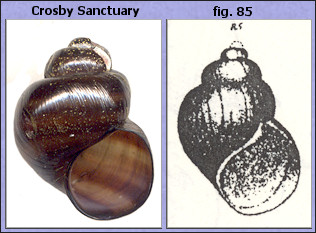 Viviparus georgianus
(I. Lea, 1834), the Banded Mysterysnail, has the distinction of being one of the
29 species described in the first scientific conchological publication by an
American author (Say, 1817). Although he suspected it was somewhat different,
Thomas Say (1787-1834) nonetheless identified his material as Lymnaea
vivipara and referred to Helix vivipara Linnaeus (1758: 772-773;
species 603) as presented by the Englishman William Donovan (1801: plate 87).
This latter taxon is now recognized as exclusively Old World in distribution.
Seventeen years later, a fellow Philadelphia Quaker, Isaac Lea (1792-1886),
recognized this, described it as new to science, and gave it a new name,
Paludina georgiana. This cognomen, after generic reassignment, is how we
know this
snail today, yet its relevant taxonomic history dates to the dawn of binominal
nomenclature and even earlier (see Linnaeus, 1758). A Crosby specimen is here
juxtaposed with Lea's type figure. The type locality is not far from here: "Hopeton, near
Darien, Georgia" (Lea, 1834: 116: pl. 19, fig. 85). Many other non-marine mollusks were
originally collected in or very near Hopeton, the plantation of James Hamilton
Couper, a renaissance man who played a prominent role in the elucidation of the
malacofauna of the Old South (Lee, 1978: 4-5). Taxa like
Littoridinops tenuipes (Couper, 1844), Triodopsis hopetonensis, and
Anodonta couperiana commemorate his industry. Viviparus georgianus
(I. Lea, 1834), the Banded Mysterysnail, has the distinction of being one of the
29 species described in the first scientific conchological publication by an
American author (Say, 1817). Although he suspected it was somewhat different,
Thomas Say (1787-1834) nonetheless identified his material as Lymnaea
vivipara and referred to Helix vivipara Linnaeus (1758: 772-773;
species 603) as presented by the Englishman William Donovan (1801: plate 87).
This latter taxon is now recognized as exclusively Old World in distribution.
Seventeen years later, a fellow Philadelphia Quaker, Isaac Lea (1792-1886),
recognized this, described it as new to science, and gave it a new name,
Paludina georgiana. This cognomen, after generic reassignment, is how we
know this
snail today, yet its relevant taxonomic history dates to the dawn of binominal
nomenclature and even earlier (see Linnaeus, 1758). A Crosby specimen is here
juxtaposed with Lea's type figure. The type locality is not far from here: "Hopeton, near
Darien, Georgia" (Lea, 1834: 116: pl. 19, fig. 85). Many other non-marine mollusks were
originally collected in or very near Hopeton, the plantation of James Hamilton
Couper, a renaissance man who played a prominent role in the elucidation of the
malacofauna of the Old South (Lee, 1978: 4-5). Taxa like
Littoridinops tenuipes (Couper, 1844), Triodopsis hopetonensis, and
Anodonta couperiana commemorate his industry.
The Banded Mysterysnail has a very wide distribution in eastern North America
(Clench, 1962), and it is particularly abundant and ubiquitous in the St. Johns
River system, where their empty shells are the principal component of discrete,
massive shell mounds on the flanks of the main river. Harvard Professor and
Peabody Museum Director, Jeffries Wyman (1814-1874), arguably the original archaeomalacologist, meticulously studied all eighteen of these mounds along our
river, a destination in part forced on him by poor health. His sentinel work
(Wyman, 1875) had not quite come to press when he died suddenly, but friends saw
to its posthumous publication. Although these extensive mounds' raison d'être
had been a mystery for many years, by placing the billions of Viviparus
shells in context with archaeological evidence of human activity, he proved that
they were in fact kitchen middens and reflected centuries of Native American
habitation and resource exploitation.
To my initial bafflement, two living adult Viviparus
intertextus (Say, 1829a: 244), each about an inch in height, were found by
blindly netting the swampwater substrate at a culvert under the earthen causeway
which was our northward pathway (see image at top of page). The point was about half the 0.4 mi distance from the gate to
the power line swath. The Rotund Mysterysnail is predominantly an inhabitant of
the Ohio-Mississippi and Mobile River Systems (Clench and Fuller, 1965), and its
presence in Florida had previously only been hypothetical (Thompson, 1984: 17;
2004) and then possibly only in the panhandle (Thompson,
2004: species
13b). Say's description of Paludina intertexta was reprinted in
Binney (1858: 146) and is reproduced below.
While there was no type figure, the
author redescribed and figured this species in his magnum opus, American
Conchology, two years later (Say, 1831: pl. 30, fig 3, 3a).
Those figures, depicting two different shells, are here juxtaposed with images
of one of the Crosby specimens. |
|
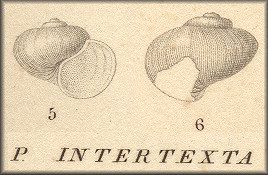 A few days later, I dissected the two specimens and found about a dozen
juveniles in the "uterus" of each. The very friable, flat-topped shells of these
"embryos" varied in size from 2 to 3 mm and had a very different appearance from
the
adult
shells from which they were taken
and from unborn of V. georgianus. They are perfectly
represented in an engraving taken from Haldeman (1871: pl. 10, figs. 5, 6).
Besides yielding some insight into the allometric growth of this species and the
fundamental morphological differences between it and V. georgianus, this
discovery unequivocally documents reproduction in this novel, isolated
population. In their own small way, these Rotund Mysterysnails and their story
emphasize the value of aquatic preserves and lend the Crosby Sanctuary a little
more credence as a refuge in this world of rampant growth and habitat
destruction.
A few days later, I dissected the two specimens and found about a dozen
juveniles in the "uterus" of each. The very friable, flat-topped shells of these
"embryos" varied in size from 2 to 3 mm and had a very different appearance from
the
adult
shells from which they were taken
and from unborn of V. georgianus. They are perfectly
represented in an engraving taken from Haldeman (1871: pl. 10, figs. 5, 6).
Besides yielding some insight into the allometric growth of this species and the
fundamental morphological differences between it and V. georgianus, this
discovery unequivocally documents reproduction in this novel, isolated
population. In their own small way, these Rotund Mysterysnails and their story
emphasize the value of aquatic preserves and lend the Crosby Sanctuary a little
more credence as a refuge in this world of rampant growth and habitat
destruction.
Pomacea paludosa (Say, 1829) is aptly dubbed the
Florida Applesnail as it is endemic to our state. Like the Banded Mysterysnail,
when it was originally reported in the scientific literature, the name applied
to it required correction. In this instance, it was not a misidentification but a
nomenclatorial gaffe that accounted for the problem. Initially the name Ampullaria
depressa Say, 1824 was introduced for snails collected by Say in 1818 at
"Mr. Fatio's Plantation" (Say, 1824: 12, 13; plate 14, fig. 3) and by John
Eatton LeConte (1784 – 1860), who conducted an official expedition to discover
the source of the St. Johns River under the auspices of Secretary of War John C.
Calhoun in 1822 (Lee, 1978: 6-7). This LeConte, like his brother, son and
nephews of the same surname, was a renaissance
naturalist
in the style of their Georgia low country neighbor, James Hamilton Couper (Lee,
1978: 4-7). Beside bringing to light several mollusks, J. E. LeConte discovered
new herps, mammals, insects, and plants during his peregrinations in the
American Southeast in the service of the US Army Corps of Engineers.
It seems quite likely a son of Francis Philip Fatio
(1724-1811), a Swiss immigrant turned Florida planter (Historical
marker)
on the St.
Johns River in New Switzerland, St. Johns Co., was
host to Thomas Say and his party in early 1818 (see Lee, 2007 and
Daedalochila auriculata (Say, 1818) Ocala Liptooth).
The elder
Fatio had welcomed William Bartram, Say's great uncle, 44 years earlier
<
http://www.unf.edu/floridahistoryonline/Plantations/plantations/New_Switzerland.htm
>.
Beside the first
scientifically-collected Florida Applesnail, Say found the type material of the
Florida endemic landsnail, Polygyra [now
Daedalochila] avara, in the "orange groves of Mr. Fatio"
(Say, 1818: 276) during the visit.
As
mentioned above, Thomas Say's original name for this applesnail, Ampullaria
depressa is not legit. From the early days of binominal nomenclature, and as
now codified in the provisions of the "Code" (ICZN, 1999: Article 52), the name
A. depressa Say was unavailable for purposes of taxonomic nomenclature
because it is a primary junior homonym of A. depressa Lamarck, 1804 [a
Middle Eocene marine moonsnail-like fossil and type of the genus Ampullina
Bowdich, 1822 (now Campaniloidea: Ampullinidae)]. Five years later, after Say
had rusticated himself in New Harmony, Indiana, he indicated the nomenclatorial
predicament and replaced his Ampullaria depressa with A. paludosa
(Say, 1829b: 260; Say, 1840: 22). It is by this time-honored cognomen, after
generic reassignment, that the Florida Applesnail has been known since. A fine
rendition of a living specimen is figured here: Pomacea
paludosa hand colored plate.
Thus, through just the small lens of malacology, the history of geographic
and biological exploration has weaved a fine fabric, one which envelops
Riverkeepers, ecologists, conservationists, and other votaries of the natural
environment. The vision of the Crosbys and the DAS, who have endowed posterity
with the framework to appreciate this rich heritage, should be applauded.
Acknowledgements: The author expresses his gratitude to the DAS and Pete
Johnson for the opportunity to conduct this study and for the provision of the
habitat photograph used in this report, to Heather McCarthy for the germination
of the project, and to these two individuals and Kelly Savage for excellent
leadership and assistance in the field. William Frank is thanked for
professional editing of the images and formatting the text and Richard I.
Johnson for sharing his copy of the "holy grail" of American malacology, Thomas
Say's first conchological work (Say, 1817).
APPENDIX:
Mollusca of
the DAS Crosby Sanctuary, Orange Park, Clay Co., Florida
Phylogenetic order and linked to figure(s), not necessarily Crosby Sanctuary
specimens: 1980 = A; 2010 = B
Aquatic species
Elliptio ahenea (I. Lea, 1847)
Southern Lance A
Elliptio jayensis (I. Lea, 1838)
Florida Spike A
Elliptio occulta (I. lea, 1834)
Hidden Spike A B
Taxolasma paulum (I. Lea, 1840) Iridescent Lilliput A
Uniomerus carolinianus (Bosc, 1801)
Florida Pondhorn A
Eupera cubensis (Prime, 1865) Mottled Fingernailclam A
Pisidium punctiferum (Guppy, 1867) Striate Peaclam A
(non native species)
Sphaerium occidentale (Lewis, 1856) Herrington Peaclam A B
Campeloma floridense (Call, 1886)
Purple-throat Campeloma A
Viviparus georgianus (I. Lea, 1834)
Banded Mysterysnail A B
Viviparus intertextus (Say,
1829) Rotund Mysterysnail B
Pomacea paludosa (Say, 1829) Florida
Applesnail A B
Amnicola dalli johnsoni (Pilsbry,
1899) North Peninsula Amnicola A
Aphaostracon rhadinum
F.
Thompson, 1968 Slough Hydrobe A
Floridobia fraterna (F.
Thompson, 1968) Creek Siltsnail A
Pseudosuccinea columella (Say, 1817)
Mimic Lymnaea A
Physella heterostropha (Say, 1817)
Pewter Physa A B
Planorbella duryi (Wetherby, 1879)
Seminole Rams-horn A B
Laevapex fuscus (C.B. Adams, 1841) Dusky Ancylus A
Terrestrial species
Gastrocopta tappaniana
(C.B. Adams, 1841) White Snaggletooth B
Pupisoma dioscoricola
(C.B. Adams, 1845) Yam Babybody B
Oxyloma effusum (L. Pfeiffer, 1853) Coastal Plain
Ambersnail A
Punctum minutissimum
(I. Lea, 1841) Small Spot A B
Euconulus trochulus
(Reinhart, 1883) Silk Hive A B
Glyphyalinia umbilicata
(Singley in Cockerell, 1893) Texas Glyph B
Hawaiia minuscula (A. Binney,
1841) Minute Gem B
Ventridens demissus
(A. Binney, 1843) Perforate Dome B
Euglandina rosea (Férussac,
1821) Rosy Wolfsnail A
Mesodon thyroidus (Say, 1817) White-lip
Globe B
Polygyra cereolus
(Mühlfeld, 1816) Southern Flatcoil B
Binney, W. G. 1858. The complete writings of Thomas Say on the conchology of the
United States. H. Bailliere Co., New York. vi + 1-252 + 75 plates.
Clench, W. J., 1962. A catalogue of the Viviparidae of North America with notes
on the distribution of Viviparus georgianus Lea. Occ. Pap. Mollusks 2:261-287.
Clench, W. J. and S. L. H. Fuller, 1965. The genus Viviparus (Viviparidae)
in North America. Occ. Pap. Mollusks 2(32):261-287. July 9.
Donovan, E. 1801. The Natural History of British Shells, including figures
and descriptions of all the species hitherto discovered in Great Britain,
systemically arranged in the Linnean manner, with scientific and general
observations on each. Natural History of British Shells 3. Author and F. and
C. Rivington: London. [i], pls. 73-90.
Haldeman, S. S., "1842-1845" [1840-1871]. A monograph of the freshwater
univalve Mollusca of the United States: including notices of species in other
parts of North America. J. Robson, Philadelphia. 231 pp. + 40 pls. (colored
with duplicate B&W). [No. 1, 1840. Paludina. pp. 1-16, pls. 1-5, Suppl.
to No. 1, 1840. pp. 1-3; No. 2, 1841. Paludina. pp. 17-32, pls. 6-10; No.
3, 1841. Limnea. pp. 1-16, pls. 1-5; No. 4, 1842. Limnea. pp.
17-32, pls. 6-10; No. 5, 1842. Limnea. pp. 33-55, pls. 11-15; No. 6, 1842
[1843]. Physadae. pp. 1-40, pls. 1-5; No. 7, 1844. Planorbis. pp. 1-32,
pls. 1-4, Ancylids. pp. 1-14, pl. 1, index to Physadae, 2 pp.; No. 8,
1845. Amnicola. pp. 1-24, pl. 1, Ampullaria. pp 1-11, pls. 1-2,
Valvata. pp 1-11, pl. 1; No. 9, 1871. Paludina. pp. 33-36, pl. 11,
index to Turbidae, corrections, contents, pp. 41-43].
ICZN (International Commission for Zoological Nomenclature), 1999.
International Code of zoological nomenclature fourth edition. International
Trust for Zoological Nomenclature, London. pp. 1-306 + i-xxix.
<
http://www.nhm.ac.uk/hosted-sites/iczn/code/index.jsp
>
Lea, I., 1834. Observations on the naiades; and the descriptions of new species
of that and other families. Last part. Transactions of the American
Philosophical Society 5: 114-117. pl. 19, figs. 81-86. Read 18 April.
Lee, H. G., 1978. Nineteenth Century malacologists of the American South.
Bulletin of the American Malacological Union, Inc., 1977: 4-8.
Lee, H. G., 2007. The Ocala Liptooth reprised after ninescore years.
Shell-O-Gram 48(5): 1, 3-4. September. See also
Daedalochila auriculata (Say, 1818) Ocala Liptooth.
Linnaeus, C, 1758. Systema naturae per regna tria naturae, secundum classes,
ordines, genera, species cum characteribus, differentiis, synonymis, locis.
Tomus I. Editio duodecima, reformata. Laurentius Salvius, Holmia
(Stockholm). Pp. 1-823 + i. [Reprinted in facsimile by the British Museum of
Natural History, London, 1956 (+ v).]
<
http://gdz.sub.uni-goettingen.de/no_cache/dms/load/img/?IDDOC=265100 >
McCarthy, H. P. and L. M. Lisenby, 2010. Sandhills, swamps, & sea islands
Environmental guidebook to northeast Florida. University of North Florida
Environmental Center, Jacksonville. x + 1-276. August.
Say,
T., 1817. Conchology. In Nicholson, W. [The
first] American Edition of the British Encyclopedia or Dictionary of Arts and
Sciences Comprising an accurate and popular view of the present state of Human
Knowledge volume 2 (of 6). A. Mitchell and H. Ames, Philadelphia. [1-14] +
plates 1-4.
Say, T., 1818. Account of two new genera, and several new species, of fresh
water and land shells. Journal of the Academy of Natural Sciences of
Philadelphia 1(2): 276-284.
Say, T., 1824. Appendix Section I. Zoology pp. 1-104 [mollusks 5-13 + plates
14-15] in Narrative of an expedition to the source of St. Peter's River,
etc., under the command of Major Stephen H. Long. Long's Expedition 2.
Philadelphia. vi+ 1-248 + 1-156. <
http://books.google.com/books?id=3YkUAAAAYAAJ&printsec=frontcover&dq=Long #>
[see "pp." 252 and (second iteration) 12, 13].
Say, T., 1829a. Descriptions of some new terrestrial and fluviatile shells of
North America [second installment]. The New Harmony disseminator of useful
knowledge 2: 243-258. Aug. 12. Not seen, but reprinted in Say, 1840 [q.v]
and available on-line at <
http://www.biodiversitylibrary.org/item/33429#24> [see pp. 20-21] and see
Binney (1858: 146).
Say, T., 1829b. Descriptions of some new terrestrial and fluviatile shells of
North America [third installment]. The New Harmony disseminator of useful
knowledge 2: 259-265. Aug. 26. Not seen, but reprinted in Say, 1840 [q.v]
and on-line at <
http://www.biodiversitylibrary.org/item/33429#24> [see pp. 22] and see
Binney (1858: 147).
Say, T., "1830" [1831]. American Conchology, or descriptions of the shells of
North America. Illustrated by colored figures from original drawings executed
from nature 3. Thomas Say, New Harmony, Indiana. [40 pp., unpaginated] +
pls. 21-30. Sept.; Sept.
Say, T. [ed. L. Say], 1840, Descriptions of some terrestrial and fluviatile
shells of North America. 1829, 1830, 1831. Lucy Say, New Harmony, IN. Title page
+ [i] + [5]-26. After March. <
http://www.biodiversitylibrary.org/item/33429#24>.
Thompson, F. G., 1984. The freshwater snails of Florida A manual for
identification. University of Florida Press, Gainesville. x + 1-24.
Thompson, F. G., 2004. The freshwater snails of Florida A manual for
identification. Florida Museum of Natural History, Gainesville. <
http://www.flmnh.ufl.edu/natsci/malacology/fl-snail/snails1.htm>; last
edited 6 March.
Wyman,
J., 1875. Fresh-water shell mounds of the St. John's River, Florida.
Memoirs of the Peabody Academy of Science 1(4): 3-94. |
